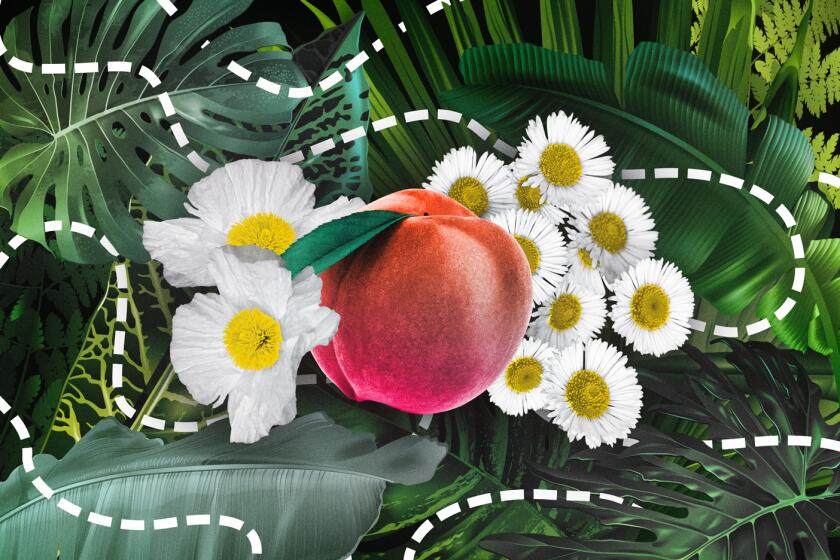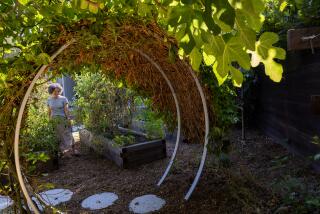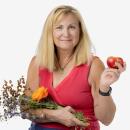
- Share via
- Fruits and vegetables need plenty of nutrients and water to thrive in a garden.
- California native plants prefer unamended soils and need little water once they’re established.
- Separation is the key to creating an edible habitat garden that feeds humans and wildlife.
Here’s the dilemma: Fruits and vegetables are among the neediest of flora because they require lots of nutrients and water to produce the delicious, healthful foods we love to eat. California native plants, on the other hand, prefer leaner and much dryer soils.
Given that most SoCal gardeners are working in restricted space, what if we want to grow food for humans while also creating habitat with native plants to, you know, help save the world?
You can do both, and very handsomely, experts say, by creating an edible habitat garden that separates the very different water and nutrient requirements of the plants that feed humans and the native plants that pollinators and other wildlife need to thrive.

The key is something landscape designer Sophie Pennes calls “hydro-zoning, when we pair plants by watering zones.”
Essentially, most native plants prefer unamended soils and need little water once they’re established. In fact, the regular watering that most vegetables need to thrive can be a death knell to native perennials, especially in late summer, when many go dormant.
“You have to keep them on separate irrigation zones,” said Tim Becker, horticulture director for the Theodore Payne Foundation. “That’s most important because you do water frequently for veggies, and you do not water frequently for natives.”
Moreover, Becker said, native plants have adapted to growing in poor soils and don’t do well in amended soils that are rich with the nutrients vegetables crave.

The trick, said Pennes, is to grow vegetables and fruits in separate raised beds and then interlace the remaining ground with native plants. That way you can enrich the soil for your fruits and vegetables and let native plants grow in the unamended soil they prefer.
In fact, many native plants don’t need regular irrigation at all once they’re established with root systems that find water deep in the ground, so if you plant native perennials, say, around the outside of the raised beds, the mature plants likely will get all the water they need from the vegetable beds.
Pennes’ firm, Urban Farms LA, initially specialized in creating vegetable gardens, but over time its focus has shifted more to creating habitat gardens and water harvesting (i.e., creating landscapes that retain rainwater).
That focus was an attraction for Hayden and Hannah Coplen when they relandscaped their small West Adams yard in November 2023.

Hayden, a musician and music agent, loves hiking high in the San Gabriel Mountains — “No place gives me more peace,” he said — but with their jobs and 2-year-old son Silas, making the long drives to his favorite hiking haunts is more difficult these days. So his goal was to try to re-create those native landscapes around his home.
Hannah, on the other hand, is a gardener and cook who wanted to expand the small vegetable patch in their mostly concrete backyard while making a welcoming workspace for her home business creating merchandise for progressive political campaigns.
Pennes found a way to give them both, by creating a rocky, dry-lake area in their small front yard to capture rainwater — designed from photos of a creek bed Hayden took during a hike up Cooper Canyon — and surrounding it with mostly native trees and shrubs.
In the small backyard, Pennes built three raised beds for vegetables — two with trellises — on one side of their side-yard sidewalk, with a narrow line of mallow, verbena and other flowering native plants on the other side.
A dwarf lemon is flourishing nearby, next to large containers holding rosemary, a Mexican lime tree and a small manzanita. Beyond the vegetable beds is a planting area of native shrubs and grasses to provide additional habitat and permeable surface to collect rainwater.
The rest of the small backyard holds a raised deck outside their kitchen, an office space where both Hannah and Hayden work, a narrow lap pool and postage-stamp-size lawn of St. Augustine grass where Silas and dog Dizzy can play. The fence beside the pool is completely covered by a vigorous and very fertile passion fruit vine, which plays a big role in their frequent outdoor gatherings.
“We make the best margaritas with this passion fruit!” Hayden said. “It’s now our house signature cocktail. And we eat off our garden all the time. I had a spinach smoothie from the garden this morning and when we had people over last Saturday, we ate a hummus Hannah made with garbanzo beans and our beets, which we ate with celery and radishes from the garden as well.”
Finding your favorite nursery can be thrilling. Here are our picks for the best independently owned plant nurseries near Los Angeles.
In Eagle Rock, certified public accountant Zach Smith and his wife, Jennifer Strong, marketing and communications director for the Lundquist Institute for Biomedical Innovation, took a similar route to create their edible habitat, which they’ve dubbed Tonawanda Farm. Their unique front-yard landscape features deck and pebble walkways linking deep raised beds made from stacked bits of broken concrete where they grow vegetables, cutting flowers and fruits.

The ideas came from Smith’s longtime friend, landscape architect David Godshall, owner of Terremoto, a landscape architecture design studio. The nearly 100-year-old house was mostly landscaped with lawn, plus a long concrete driveway from the street to the garage in the back, said Strong.
Marie Massa has spent more than three years working mostly alone to transform a weedy strip of public land into a fragrant habitat garden in Lincoln Heights.
“David encouraged us to rip out our long driveway and use the broken concrete to create our garden boxes in front,” Strong said. Initially she was worried about converting the driveway to rounded pebbles, but the change gave them more planting space and allowed the property to capture rainwater instead of it running off the concrete. And using the broken concrete to build the garden boxes allowed them to make long, tall beds that are easy to use for planting, weeding and just sitting.
Smith is a swimmer who feels strongly about water conservation, she said, and the pebbles turned out to not be an issue. “The hardest thing is pulling our trash cans out to the street,” she said. “But driving and walking on them has been just fine.”


Jennifer Strong and Zach Smith transformed the lawn and concrete driveway in front of their Eagle Rock home in 2022, left, into long raised beds for growing food connected with pebble and deck walkways, right. (Jennifer Strong; Yasara Gunawardena / For The Times)
In their large backyard, they were able to create a meadow of native wildflowers and grasses that Strong has dreamed about since she was a child visiting her grandparents’ apple farm in Washington’s Spokane Valley, where wildflowers and grasses grew between the orchard rows.
The meadow is surrounded by pathways to a variety of fruit trees — avocado, fig, cherry, olive, peach, apple and citrus — as well as boxes full of herbs, a row of blueberries and a rustic coop to house their three chickens. And Strong, an enthusiastic cook, luxuriates in the bounty of fruits and vegetables growing around their home.
Are you growing food, flowers and other plants on a patio, balcony or deck? Tell us about your small-space container garden so we can share what you’ve learned.
Almost all the plants in their garden are California natives, except for the plants producing food, such as their giant artichoke bush, or flowers for bouquets. The one exception is a pot of orange-flowered tropical milkweed, a non-native variety they keep for sentimental reasons because it reminds them of how they met when they both were single living in Santa Monica. Smith’s dog Cola was fascinated by butterflies and always stopped to look at the monarchs attracted to the milkweed in Strong’s front yard. Strong and her dog Olive then began taking walks with Smith and Cola.

Now their gardens and the Coplens’ are alive with pollinators such as butterflies, bees and hummingbirds as well as other beneficial insects we don’t usually consider.
“Native plants attract predatory wasps,” said Becker, “so you’re getting natural pest control for your fruits and vegetables. As a general rule, any assemblage of native plants, with lots of different types of flowers [blooming] at different times of the year, is good for veggie gardening because you’re getting the benefit of ecology in the background acting as a good source for pollinators and beneficials.”

In fact, Becker said, adding hedgerows of native plants where pollinators could live and reproduce “was a traditional way of farming before we became so heavily focused on petrochemicals. Having these plants near your place of cultivation gives you plenty of benefits.”
Hayden Coplen certainly agrees. His family’s tiny “farm” is flourishing, although he credits some of that success to his wife’s increased prowess in the garden. But creating a landscape of vegetables and native plants has another benefit as well, he said.
“It makes me happy,” he said. “I look out my bedroom window and see the healthy places where Silas plays and it has an effect on me. I get a sense of place, like a little oasis. It grounds me, and it makes me feel good.”














